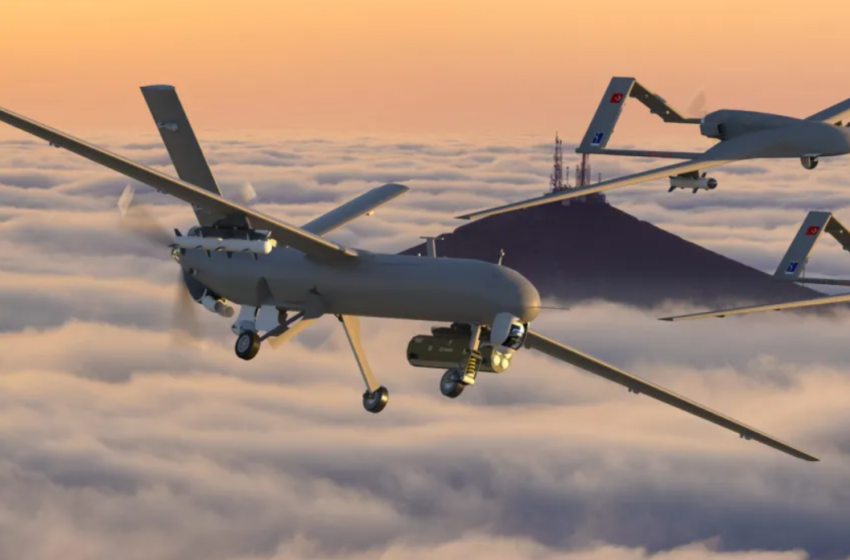
Drone War And Turkish Delight
The conflict in Ukraine has confirmed Turkey’s status as a drone superpower.
Source: The American Conservative
First in Ethiopia and now Ukraine: Turkish-made armed drones that helped turn the tide in Ethiopia’s conflict are adding to the Russian military’s many headaches in Ukraine.
Weighing an eighth of the U.S.’s high-tech Reaper drone, the relatively small and low-tech Bayraktar TB2 drone can cruise for about 24 hours with its payload of four small laser-guided munitions. And just as it did in Ethiopia and other lesser-known conflicts before, the low-key design is proving itself during the war in Ukraine.
“The Ukrainian air force has been effective at detecting and rapidly exploiting the gaps in Russian forces’ air defense and electronic warfare coverage with its [TB2] drones,” Justin Bronk wrote at the Spectator. “The surprising inability of the Russian Air Force to destroy Ukraine’s own mobile surface-to-air missile (SAM) systems and establish air superiority has meant its fighters have not been able to hunt the TB2s down at medium and high altitudes.”
Of the more than 1,200 Russian vehicles and heavy weapons confirmed to have been destroyed, the TB2s have reportedly accounted for the destruction of 18 armored vehicles, 24 trucks, and two fuel resupply trains. That small proportion doesn’t account for how, as in Ethiopia, the threat of attack from a quiet and unseen menace will take a psychological toll on the Russian soldiery, whose morale is already badly knocked. That threat will also impinge on the tactics and freedom of movement of Russian forces.
With more time the Russian military may well improve air-defense coverage and its electronic-warfare capabilities, limiting the TB2’s effectiveness, Bronk notes. Regardless of how the rest of the war goes, the TB2’s deployment in Ukraine so soon after the weapon’s success in Ethiopia has shone further light on the scale and sophistication of Turkey’s drone program. For years, as most looked the other way, Turkey has honed the craft of drone warfare.
The U.S. remains the world’s preeminent force in military drones, both in terms of numbers, capability, and spending. After all, the U.S. was there at the beginning, spearheading drone development during the Afghanistan war, and it has far more resources to draw on than Turkey. But Turkey is doing well with what it has: The TB2 can be bought for around $5 million—a bargain compared to the $32 million Reaper, and one of the reasons it has proved so popular a purchase among participants in the world’s conflicts. Turkey is pulling ahead of most other Western militaries in terms of its own armed-drone capability; its army reportedly operates more than 140 TB2s. Compare that to the U.K., which has a drone fleet of just ten U.S.-made Reapers that are two decades old.
The emergence of the TB2 over the Ukraine battlefield also highlights the strained-frenemy relationship between Turkey and Russia, in which Turkish President Recep Tayyip Erdogan and Vladimir Putin maintain a dialogue despite having found themselves on opposite ends of various conflicts. Those were initially distant proxy wars but have inched ever closer to Russia’s home turf, as Nicholas Velazquez recently observed. The TB2 was used to strike at Russian-backed forces in the Libyan and Syrian civil wars. This was followed by highly successful usage of the drone by the Azeri forces in the Second Nagorno-Karabakh War in Azerbaijan.
“Turkey effectively concluded one of the ‘frozen conflicts’ of the former Soviet Union through the simple export of a fleet of drones,” Velazquez wrote.
The conflict in Azerbaijan had Turkey competing with Russia in the “near abroad”: those post-Soviet states, of which Ukraine is one, that Russia counts within its sphere of influence.
In 2019 Ukraine bought at least six TB2s from Turkey, according to Breaking Defense, a digital magazine on defense strategy, politics, and technology. That October, the drone was used for the first time by the Ukrainian military in combat: against Russian-backed separatists in Ukraine’s eastern Donbass region. Last year, Ukraine struck a deal with Turkey to co-produce the TB2 domestically. The Ukrainian government indicated it wanted to buy 24 additional TB2 drones.
Turkey is working on its new Akinci drone, which is supposed to be much more sophisticated. The company making it claims it will be “the most powerful and combat-capable armed UAV [unmanned aerial vehicle] in its class in the world.” That will give Russian military strategists—as well as strategists in other countries—something to think about. So will Turkey’s continuing development of drone-swarm technology, and its tactic of linking up large numbers of UAVs for coordinated attacks. It employed this strategy in the skies above Nagorno-Karabakh to such a devastating degree, some claim, that it could be considered a revolution in military affairs, heralding the direction of future warfare and leaving even the U.S. drone program playing catch-up.
